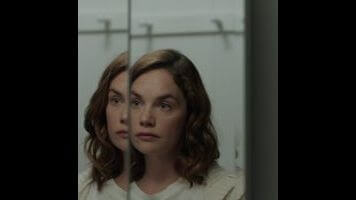I Am The Pretty Thing That Lives In The House creeps by on spectacular mood

Can a horror movie get by on nothing but atmosphere, on the je ne sais quoi of its unsettling mood? I Am The Pretty Thing That Lives In The House suggests that maybe it can. This curious object with a curious title is the second feature from writer-director Oz Perkins, son of Psycho star Anthony Perkins. Does horror run through the filmmaker’s veins or is he just a very fast learner? Perkins’ first feature, a kind of new-millennium Suspiria called The Blackcoat’s Daughter, is still awaiting its theatrical release, more than a year after it freaked out festivalgoers under the title February. With his follow-up, arriving on Netflix tomorrow, Perkins commits even harder to his singularly strange approach to the genre, turning a simple ghost story into an exercise in extremely prolonged unease. It could give Norman Bates the willies.
From the very first scenes, Perkins establishes where his priorities lie. The film is set over a single year and entirely in one location, the rural Massachusetts house where hospice nurse Lily (The Affair’s Ruth Wilson) arrives to care for the aged, ailing Iris Blum (Paula Prentiss), a retired author of airport-fiction horror novels. The house is haunted, but doesn’t look especially spooky: It’s old but not dilapidated, with lots of natural light and neutral colors. Rather than tease a supernatural presence, Perkins reveals it immediately, opening on the ghost—a blurry specter in white lace, like something out of a faded Victorian storybook—flickering softly from the shadows. There will be no ambiguity about whether this apparition is real or imagined, nor any suspense about where the story might be going: “Three days ago, I turned 28 years old,” Lily reveals through her first-person narration. “I will never be 29.”
I Am The Pretty Thing That Lives In The House doesn’t want to jolt you out of your seat. It wants to burrow under your skin and stay there. The film freezes bloodstreams through a variety of unique methods. A distinctly literary voice-over runs throughout—not for expository purposes, but to set a musty, from-beyond-the-grave tone, like Emily Dickinson meets Edgar Allan Poe. Lily’s detached musings often mingle with passages from one of the elderly woman’s novels, a ghastly thing called The Lady In The Walls, with Perkins cutting to story-within-the-story flashbacks to a doomed young woman (played by Sing Street’s Lucy Boynton, who appears in the director’s first movie). There’s also something unnervingly, even anachronistically affected about Wilson’s lead performance; her Lily comes across like a neurotic 1950s wallflower, babbling to herself to calm her failing nerves. (The spooked caregiver’s meetings with her employer, played by a dryly amusing Bob Balaban, put a small eternity of dead air between each line of their awkward conversation.)
Perkins isn’t above the occasional well-timed jolt, administrated through the reflection of a rabbit-eared television or the sudden swing of a sharp object. But these moments feel supplementary, even obligatory. The filmmaker seems more interested in seeing how long he can sustain a disquieting aura, extending silences, darkening shadows, and engulfing us in the nightmare subjectivity of Lily’s fear. It’s the kind of movie that lends mundane details, like an unoccupied kitchen chair, an ominous significance, just for how long they occupy the center of a frame. The mounting dread is enhanced by the music of the director’s brother, folk rocker Elvis Perkins: a distant, spooky warble that sounds like it’s floating up from an underwater ballroom.
Opening with a dedication to the filmmaker’s famous father, I Am The Pretty Thing That Lives In The House conjures one moment of Janet Leigh-worthy terror, transmitted almost entirely through its lead actress’ reaction shot. After more than an hour of build, it’s the closest this very slow burn gets to a conventional payoff. Otherwise, Perkins contents himself playing a single note of consuming creepiness for 87 minutes—a strategy destined to turn off horror buffs seeking traditional scares. But the director has developed a style so unique, so controlled, and so out of step with contemporary fright-flick trends that even those disappointed with its repetitions may find it tough to entirely shake. Pity the film’s only streaming: The eerie glow of its images and the immersive hush of its sound design deserve to be experienced on the big screen. Since that’s not possible right now, dim the lights, draw the curtains, and fall under its spell.